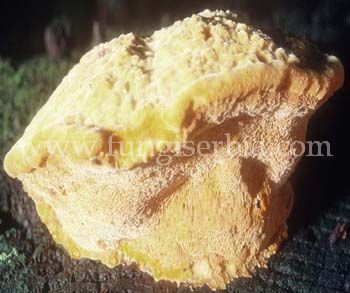Hapaloppilus croceus (Pers.) Bondartsev & Singer

Fruitbody: wide up to 15 cm, long up to 5 cm and thick up to 10 cm. Upper surface at first bright orange later brown-orange. Hymenial surface is the same colour, pores angular (2 to 3 on 1 mm), tubes up to 12 mm.
Microscopy: spores broadly ellipsoid, smooth, hyaline, 4-7x3-4.5 μm.
Flesh: soft and hygrophanous when young, later hard, slightly bitter taste.
Chemical reaction: with strong bases (e.g. KOH) reacts red to carmine.
Habitat: usually on oak (Quercus) and rarely on chestnut (Castanea).
Edibility: inedible.
Reference: Ryvarden, L., Gilbertson, R.L. (1993). European polypores Part 1, Synopsis fungorum, vol. 6, p.1-387
Photo: Walt Sturgeon